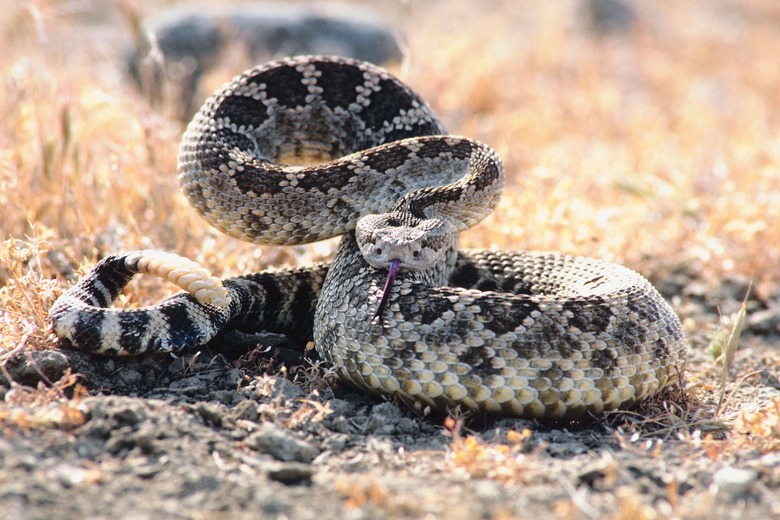Snakes In Pinal County, Arizona
Arizona offers suitable habitats for over 60 species and subspecies of snake, with the county of Pinal being home to 28 species itself. Pinal County is located in south-central Arizona and lists an array of native snakes that vary greatly in size and appearance. Those living in the county likely have to remain vigilant, as eight of the local species are considered venomous and can pose considerable risk to humans.
Small Pinal Snakes
Small Pinal Snakes
The smallest of Pinal County's snakes is the variable sand snake, which grows less than a foot in length. It has a distinct yellowish-orange and black striped pattern running the length of its body. The Tuscon subspecies of the western shovel-nosed snake lives in the county and is recognizable from its flattened, elongated nose. Other small snakes that live in the area include the desert night, saddled leaf-nosed, spotted leaf-nosed, ground, Smith's black-headed and the western thread snakes. None of these species grows to be more than 2 feet, on average.
Medium-Size Pinal Snakes
Medium-Size Pinal Snakes
The checkered garter snake is native to the county and has a distinct black and white checkered pattern along its body. Like several other local species, such as the black-necked garter, Arizona glossy, desert patch-nosed and Sonoran lyre snakes, it grows to just under 4 feet in length. The eastern patch-nosed snake lives in parts of far eastern Pinal County and grows to around 3 feet in length. As the name suggests, it has an enlarged scale on the tip of its snout which looks like a patch.The long-nosed snake and ring-necked snakes are similar in size at around 3 feet.
Large Pinal Snakes
Large Pinal Snakes
Large snakes are less common in the county, with the largest being the Sonoran gopher, a subspecies of the gopher snake. It grows to over 7 1/2 feet in length and has a thick, tan-colored body covered with darker mottled spots. The second largest species in the area is the Sonoran whip which falls just under 6 feet in length and has a slender body, much like a whip. A subspecies of the coachwhip snake lives in the area and is known as the red racer. It grows to over 5 1/2 feet in length and is reddish to pink in color. The other large species in the county is the California king snake which grows to over 4 1/2 feet in length and is a subspecies of the common king snake.
Dangerous Pinal Snakes
Dangerous Pinal Snakes
The Sonoran coral snake is one of the most poisonous snakes in the area and is related to cobras and mambas. The other seven venomous snakes living in the county are rattlesnakes, including the large western diamondback which grows to around 5 1/2 feet in length. The Sonoran subspecies of the sidewinder rattlesnake lives in the area and has a distinctive sideways movement style. The Mojave rattlesnake is native to the county and can deliver large amounts of potent venom. The remaining rattlesnakes in the area are the Arizona black, speckled, black-tailed and tiger rattlers.
Cite This Article
MLA
Hayden, Nancy. "Snakes In Pinal County, Arizona" sciencing.com, https://www.sciencing.com/snakes-pinal-county-arizona-8710942/. 24 April 2017.
APA
Hayden, Nancy. (2017, April 24). Snakes In Pinal County, Arizona. sciencing.com. Retrieved from https://www.sciencing.com/snakes-pinal-county-arizona-8710942/
Chicago
Hayden, Nancy. Snakes In Pinal County, Arizona last modified August 30, 2022. https://www.sciencing.com/snakes-pinal-county-arizona-8710942/
